|
Mozart Piano Sonatas and Concertos - Piazzini, Glazer & Bilson
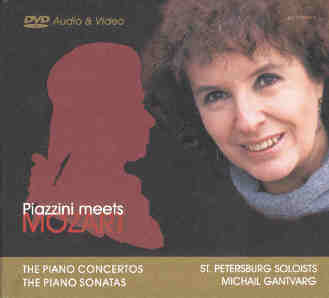
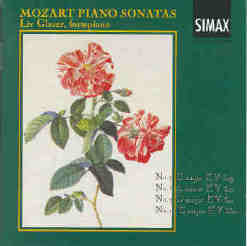
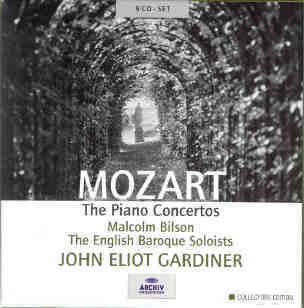
|
|
Carmen Piazzini (piano) & St Petersburg Soloists/Michael Gantvarg
Edition Hera DVD 02200
(2 DVDs - 16 hours 36 mins audio + 44 mins video)
Liv Glaser (fortepiano)
Piano Sonatas (Simax PSC 1125, 1148 & 1149)
Malcolm Bilson (fortepiano)
Piano Concertos (complete) with English Baroque Soloists/John Eliot Gardiner (with Melvyn Tan & Robert Levin
(Universal Archiv 463 111-2; 9 CDs)
Alexei Lubimov (fortepiano)
Piano Sonatas (Erato CASS 2292-45510-4)
A new technological miracle has been a spur to revisit some Mozart piano recordings.
Hera has managed to get all the concertos and sonatas onto two DVDs, packaged conveniently with a 21-page booklet in English (82 pages complete for multilingual texts).
They were produced by Ralph Kulling, who explains that he had enjoyed for many years Sunday lunchtime concerts in Stuttgart "in particular whenever music by Mozart was performed". Carmen Piazzini is an Argentinian pianist "who grew up in Buenos Aries with famous guests like Arrau, Backhaus, Gieseking, Rubinstein and Toscanini".
She lives in Germany and teaches at Karlsruhe. Her interpretations give him this very "relaxed Sunday feeling", and prompted him to publish them "on up to date media for the 251st anniversary of Mozart, whose beautiful music is always a delight, not just in years of big, official anniversaries".
The recordings date from 1989/1990 and were made in Sandhausen (sonatas) and St. Petersburg (concertos), the concertos on a Steinway D, the sonatas on a Bosendorfer. There are also didactic videos by the pianist.
The production values are high and the transfers entirely satisfactory. They are not in any way remarkable performances, but can be described as serviceable and useful; the discs coud be a boon for broadcasters, and for collectors who like to have integrales of major repertoire, and there could be no more convenient way to store them! |
However, for more choosy collectors there are many competitors, and it gives me pleasure to recommend sets (also not new) by several specialist fortepianists, plus a reminder of one of my personal favourites, the Austrian pianist Gilbert Schuchter, who plays a Bosendorfer and whose collection from the '70s puts the sonatas in context with Mozart's other piano music [Tudor 741-752].
For the sonatas, I have only recently discovered the Norwegian fortepianist Liv Glaser (see MP's reviews of her Clementi and Grieg) and her Mozart interpretations 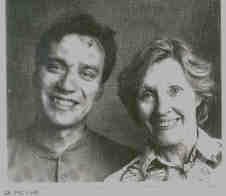 have everything you could wish. Available in UK from New Note, and absolutely not to be missed. If you trust our judgement, do explore Glaser's Schubert Schone Mullerin partnering Norwegian baritone Per Vollestad with an original Graff piano of 1825 [Simax classics PSC 1140]. have everything you could wish. Available in UK from New Note, and absolutely not to be missed. If you trust our judgement, do explore Glaser's Schubert Schone Mullerin partnering Norwegian baritone Per Vollestad with an original Graff piano of 1825 [Simax classics PSC 1140].
Just as Olga Tverskaya tells us that "the fortepiano is the only surviving witness of how Schubert's works actually sounded - - I let it tell me which tempos and dynamics are most appropriate to the style of the piece I wish to play - - I feel I am close to him, that he and I share feelings and thoughts with the listener", so does Liv Glaser find that "A. Graff has been my guide, a precious collaborator in renewed understanding" etc.
And for the concertos, in my book Malcolm Bilson has no peer in the huge Mozart discography. His recordings with John Eliot Gardiner are reissued in a no-nonsense compact box, 9 individual slip-cases with a very full 112 page fully illustrated booklet, with a wide range of essays by experts.
The particular virtue of these recordings is the true balance achieved by engineer Karl-August Naegler who does not attempt to disguise the quietness of the solo instruments (Walter/Belt and Walter/Adlam) as against the orchestra.
I have long been a devotee of period pianos, and enjoyed the first recording of the Mozart sonatas on fortepiano by the Russian specialist Alexei Lubimov, which I reviewed before my days of web-writing; so I append Richard Wigmore's appreciation from Gramophone.
Peter Grahame Woolf
Mozart Sonata for Piano No 15,K533/494 - Sonata for Piano No 16,K545 - Sonata for Piano No 17,K570 - Sonata for Piano No 18,K576
Alexei Lubimov pf
Erato CASS 2292-45510-4 ( DDD)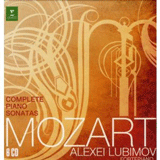
NB This set has been re-released - see an appreciative review PGW
DELETED Reviewed: Gramophone 4/1991 - - In addition to the projected complete cycles by Bilson (Hungaroton/Conifer) and Vesselinova (Accent/Gamut), we now have the first instalment of a cycle by Alexei Lubimov, long acclaimed in his native Russia but until recently little known in the West. As he explains, modern copies of three different fortepianos will be used for this series, each corresponding as closely as possible to the instrument Mozart himself played at a particular period.
For the last nine sonatas Lubimov has chosen an exact replica by Christopher Clarke of a fortepiano by Anton Walter - - one of the most attractive and characterful fortepianos I have heard, with its silvery, never jangly, treble, mellow, sonorous middle register and light, leathery bass.
The refinements of colouring, articulation and nuance unique to the fortepiano are imaginatively exploited by Lubimov, who strikes me as a player of uncommon sensibility. Like Bilson, he brings to Mozart's sonatas a degree of expressive freedom that contrasts with the slightly chilly detachment of some period-instrument music-making. He is quite liberal with rubato, in quick as well as slow movements; yet unlike some artists, his rhythmic pliancy never seems indulgent and structurally harmful, with affectionate or regretful lingerings balanced by a sense of urgent forward movement. Lubimov's passagework is fluent and even, never mechanical in its brilliance; and his articulation throughout is as crisp and pointed as one could wish, with the quick tonal fade of the fortepiano making possible phrasing that can never quite be obtained on a modern Steinway - - there is no lack of sinew in the opening movements of the two finest sonatas, K533 and K576 and ample space for K533's strangely disquieting Andante to make its full effect - - Lubimov occasionally attacks the keyboard a bit too eagerly - - but this is notably fine Mozart playing, subtle, alive and affectionate, sympathetically captured by the recording; and it had the effect of actually making me look forward to yet another cycle of Mozart's sonatas.' (Richard Wigmore)
|



